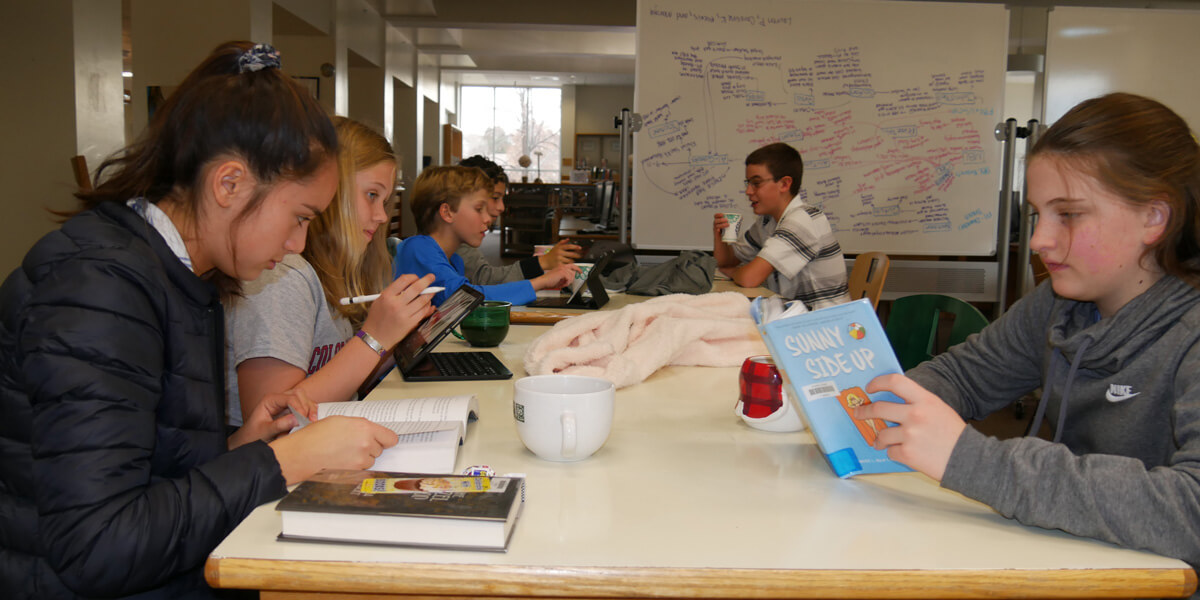If you are looking for a good book at Colorado Academy, take a stroll through the Middle School looking next to each teacher’s classroom door. Doing so, you will find what each of us is reading for pleasure. Our hope is that our students will take a look too. It may be that my interest in nonfiction and historical fiction strikes a chord and encourages a student or two to give this genre a try, or perhaps what I enjoy is not to their fancy. Either way, we hope students see that we are not just talking the talk about how fun and important reading is, but we are also walking the walk.
Sad facts about Middle School students and reading
Unfortunately, for many young adolescents, disproportionately boys, reading for pleasure declines during the Middle School years. A scholastic survey indicates that only 51 percent of students this age love or like to read. 51 percent! We know, however, that reading has tremendous benefits for young people educationally. Reading develops vocabulary, improves comprehension, supports writing fluency, and encourages the development of empathy.
So what do the experts say?
Daniel Willingham, University of Virginia professor and author of Raising Kids Who Read: What Parents and Teachers Can Do, encourages parents to reframe the reading conversation for young people. He believes that parents with the best of intentions too often frame reading as being something that will be good for school or getting into college; instead, he believes that we will have more success when we help children understand that we read because it makes our lives happier, richer, and because we love to learn. In this way, reading becomes less about school and more about a family value—loving to learn. (“How to Help Students Develop a Love of Reading,” Holly Korbey)
Many authors, including Willingham, also point to the importance of parent modeling when it comes to reading. Having kids see us read matters as does discussing our books with each other. Similarly, students benefit when families make time to read together or listen to books on tape. The authors also encourage us to explain our own screen time to our children. Many of us read books or articles on our phone or device. Without explanation, young people may believe that we are playing Candy Crush Saga, when in fact we are immersed in good literature and learning.
What matters at this age
What matters at this age is that students read for pleasure, not that they read War and Peace. In this sense, we want the book to match a young person’s reading level and interest. Graphic novels, short fiction, Sports Illustrated, even comic books can be the gateway for early readers into the world of great literature. We all have to start someplace. What matters is that kids develop an interest in reading more.
Parents may also want to limit young people’s screen time and phone access as this “distraction” can absorb time that could otherwise be spent reading. While we don’t want reading to be viewed as a punishment, creating more “down time” can encourage young people to pick up a good book. As we know, once a few pages get turned, many young people get hooked.
Fun things CA is doing to encourage reading
At CA, our librarians work hard to get students fired up about reading. Some of their efforts include:
· A summer reading contest—participants celebrate each fall when we return to school.
· Birthday books—Librarians deliver a specially selected library book to each Middle School Student on his or her birthday with a card and a sweet treat. What could be better?!
· Town Meeting Student Share-Outs—At our Town Meetings, students share a current favorite book and why it is so much fun to read.
· Book Bingo—Everyone in the Middle School has been invited to play Reading Bingo. The game board encourages students to read from a wide variety of genres. The students and class with the most completed bingo cards win individual prizes and a year-end celebration.
